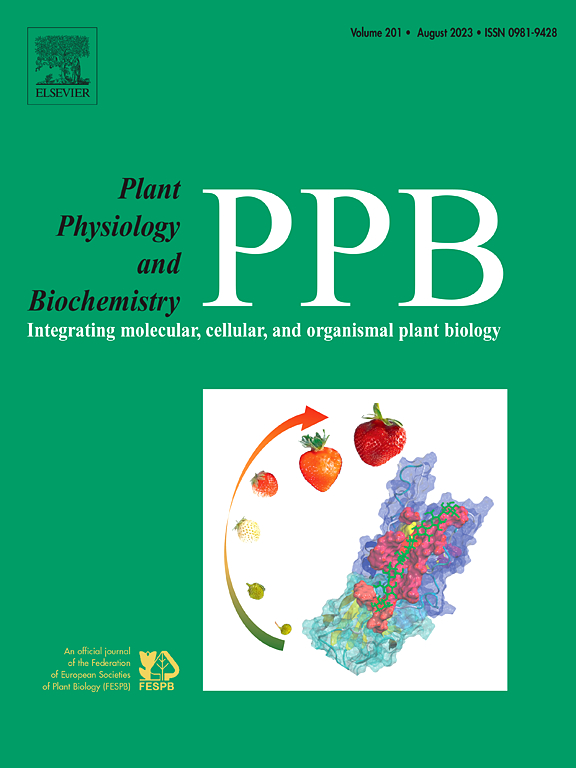Organosilicon enhances rice root suberization and antioxidant gene expression under cadmium/arsenic stress
IF 6.1
2区 生物学
Q1 PLANT SCIENCES
引用次数: 0
Abstract
Organosilicon exhibits unique physicochemical and biological properties with wide applicability across diverse fields, including agriculture and industry. Previous research has verified the effectiveness of organosilicon-modified fertilizers in inhibiting the uptake of cadmium (Cd) and arsenic (As) by plants. However, further investigations are necessary to elucidate the underlying mechanisms. In this study, we explored the potential of organosilicon to mitigate the toxic effects of Cd/As and lessen their uptake and accumulation during rice seed germination. Our results showed that under Cd/As stress, organosilicon treatments significantly increased suberin biosynthesis in rice roots. This was manifested as an increased level of root suberization and an enhanced apoplast barrier, as verified by observations made through fluorol yellow (FY) staining and transmission electron microscopy (TEM). Consequently, the uptake and translocation of Cd and As in rice seedlings were significantly reduced by 48.66 % and 72.19 % in shoots, and 43.23 % and 68.93 % in roots, respectively. Moreover, the application of organosilicon enhanced the activities of antioxidant enzymes in rice, This lead to an accelerated glutathione-oxidized glutathione (GSH-GSSG) cycle, up-regulated expression of the rice glutathione peroxidase gene (OsGPX), and increased GPX activity. These modifications effectively scavenged reactive oxygen species (ROS) generated by Cd/As stress and alleviated oxidative damage in rice. Overall, our study has unraveled the physiological and molecular mechanisms underlying the role of organosilicon in alleviating Cd/As toxicity in rice and has also provided new insights for the application of suberin in reducing heavy metal toxicity in plants.

有机硅促进镉/砷胁迫下水稻根系分化和抗氧化基因表达
有机硅具有独特的物理化学和生物特性,在包括农业和工业在内的各个领域具有广泛的适用性。已有研究证实了有机硅改性肥料在抑制植物对镉(Cd)和砷(As)吸收方面的有效性。然而,需要进一步的研究来阐明潜在的机制。在这项研究中,我们探索了有机硅在缓解Cd/As的毒性作用以及减少其在水稻种子萌发过程中的吸收和积累方面的潜力。结果表明,在Cd/As胁迫下,有机硅处理显著提高了水稻根系中亚木质素的生物合成。通过氟黄(FY)染色和透射电子显微镜(TEM)观察证实,这表现为根脱落水平的增加和外质体屏障的增强。结果表明,水稻幼苗对Cd和As的吸收和转运在地上部和根部分别减少了48.66%和72.19%和43.23%和68.93%。此外,有机硅的施用增强了水稻抗氧化酶的活性,加速了谷胱甘肽-氧化谷胱甘肽(GSH-GSSG)循环,上调了水稻谷胱甘肽过氧化物酶基因(OsGPX)的表达,提高了GPX的活性。这些修饰能有效清除Cd/As胁迫产生的活性氧(ROS),减轻水稻的氧化损伤。总的来说,我们的研究揭示了有机硅减轻水稻Cd/As毒性作用的生理和分子机制,并为亚木素在减轻植物重金属毒性方面的应用提供了新的见解。
本文章由计算机程序翻译,如有差异,请以英文原文为准。
求助全文
约1分钟内获得全文
求助全文
来源期刊
CiteScore
11.10
自引率
3.10%
发文量
410
审稿时长
33 days
期刊介绍:
Plant Physiology and Biochemistry publishes original theoretical, experimental and technical contributions in the various fields of plant physiology (biochemistry, physiology, structure, genetics, plant-microbe interactions, etc.) at diverse levels of integration (molecular, subcellular, cellular, organ, whole plant, environmental). Opinions expressed in the journal are the sole responsibility of the authors and publication does not imply the editors'' agreement.
Manuscripts describing molecular-genetic and/or gene expression data that are not integrated with biochemical analysis and/or actual measurements of plant physiological processes are not suitable for PPB. Also "Omics" studies (transcriptomics, proteomics, metabolomics, etc.) reporting descriptive analysis without an element of functional validation assays, will not be considered. Similarly, applied agronomic or phytochemical studies that generate no new, fundamental insights in plant physiological and/or biochemical processes are not suitable for publication in PPB.
Plant Physiology and Biochemistry publishes several types of articles: Reviews, Papers and Short Papers. Articles for Reviews are either invited by the editor or proposed by the authors for the editor''s prior agreement. Reviews should not exceed 40 typewritten pages and Short Papers no more than approximately 8 typewritten pages. The fundamental character of Plant Physiology and Biochemistry remains that of a journal for original results.

 求助内容:
求助内容: 应助结果提醒方式:
应助结果提醒方式:


